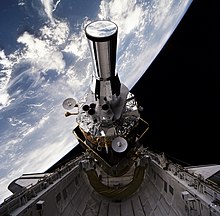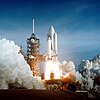STS-44
| Mission emblem | |||
|---|---|---|---|

|
|||
| Mission dates | |||
| Mission: | STS-44 | ||
| COSPAR-ID : | 1991-080A | ||
| Crew: | 6th | ||
| Begin: | November 24, 1991, 11:44 p.m. UTC | ||
| Starting place: | Kennedy Space Center , LC-39A | ||
| Landing: | December 1, 1991, 22:34:44 UTC | ||
| Landing place: | Edwards Air Force Base , runway 05 | ||
| Flight duration: | 6d 22h 50m 44s | ||
| Earth orbits: | 110 | ||
| Track height: | 365 km | ||
| Orbit inclination : | 28.5 ° | ||
| Covered track: | 4.7 million km | ||
| Team photo | |||
 v. l. No. Terence Henricks, James Voss, Frederick Gregory, Thomas Hennen, Story Musgrave, Mario Runco |
|||
| ◄ Before / After ► | |||
|
|||
STS-44 ( english S pace T ransportation S ystem ) is a mission designation for the US Space Shuttle Atlantis (OV-104) of NASA . The launch took place on November 24, 1991. It was the 44th space shuttle mission and the tenth flight of the space shuttle Atlantis.
team
Main team
- Frederick Gregory (3rd space flight), commander
- Terence Henricks (1st space flight), pilot
- Story Musgrave (4th space flight), mission specialist
- Mario Runco (1st space flight), mission specialist
- James Voss (1st spaceflight), mission specialist
- Thomas Hennen (1st Spaceflight), Payload Specialist , United States Army
Originally, David Walker provided as commander. In July 1990, he was removed from office due to an air incident in May 1989 and replaced by Gregory.
replacement
- Michael Belt for hens
Mission overview
The launch was initially scheduled for November 19, but was postponed due to a defective inertia sensor in the propulsion stage of a Defense Support Program satellite (DSP). The unit was replaced and tested, and the launch was then scheduled for November 24th. It had to be postponed another 13 minutes to allow an orbiting spacecraft to pass safely and to refuel the external liquid oxygen tank after minor repairs were done. The takeoff weight was 117,766 kg.
It was a mission for the Department of Defense ( DoD ). The non-secret payload contained the Defense Support Program satellite and its Inertial Upper Stage (IUS), which was suspended on the first day of flight. Further payloads in the payload bay and on the middle deck were Interim Operational Contamination Monitor (IOCM), Terra Scout , Military Man in Space (M88-1), Air Force Maui Optical System (AMOS), Cosmic Radiation Effects and Activation Monitor (CREAM), Shuttle Activation Monitor (SAM), Radiation Monitoring Equipment III (RME III), Visual Function Tester-1 (VFT-1), Ultraviolet Plume Instrument (UVPI), Bioreactor Flow and Particle Trajectory experiment and Extended Duration Orbiter Medical Project .
The landing was on Dec 1, 1991 at 2:34:44 PM PST on Runway 5, Edwards Air Force Base , California . The coasting distance was 11,191 feet and the coasting time was 107 seconds. The landing was originally scheduled for December 4th, but was brought forward on November 30th after a fault was found in one of the orbiter's three inertial sensors. When landing, only minimal braking was applied for test purposes, which explains the long coasting path. The orbiter returned to the Kennedy Space Center on December 8th . The landing weight was 87,918 kg.
See also
Web links
- NASA Mission overview (English)
- Video summary with comments of the crew (English)
- STS-44 in the Encyclopedia Astronautica (English)
- Michael Cassutt: Secret Space Shuttles (English)
Individual evidence
- ↑ NASA News Release 90-037 of July 9, 1990

